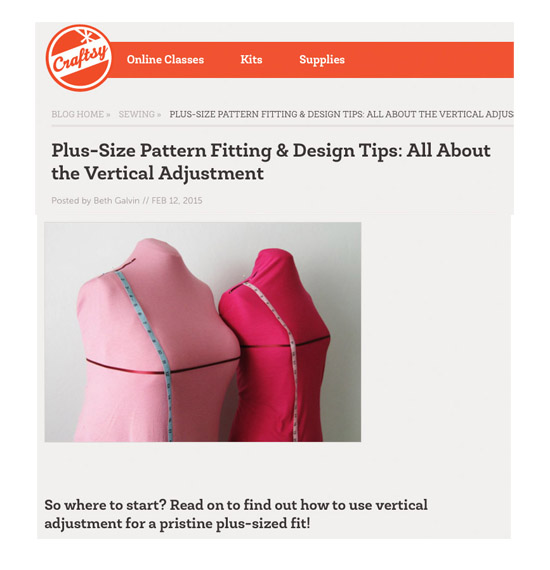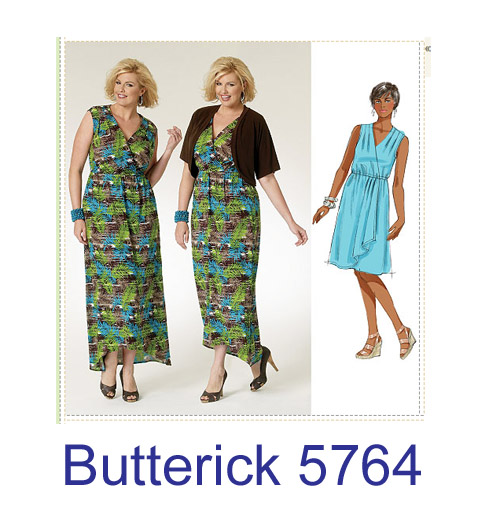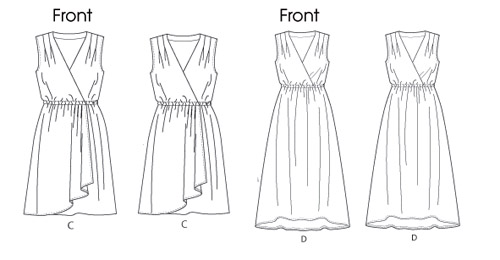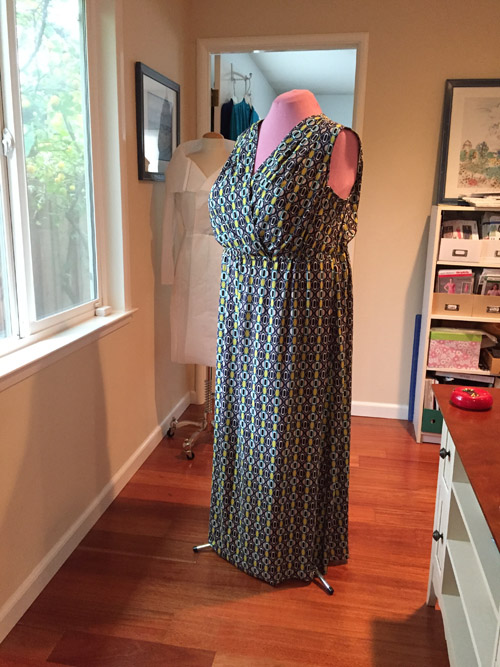This post is one I am particularly proud of - hopefully I have included some useful information that will be pertinent to anyone across all sizes who is doing pattern fitting. Which is probably all of us. If you have ever had a dress where the waist crept upwards or a horizontal seam that unintentionally bisected the bustline then you will want to read this post.
Of course fitting, for whatever shape or size is really the key to feeling great about clothes you make. Writing this post allowed me to talk my own personal fitting obsession which is bodice length.
I hope you find the post useful - I would love to know your thoughts so pop back here and leave me a comment.

As for the pattern I used which is shown in the post (and looking downright odd in the before and after examples), it is Butterick 5764 which I have had for ages and finally used to make a maxi dress for a client in flowy rayon which was ideal. Not the most appealing pattern as they have depicted it but I really liked the shoulder release darts and the cross-over front.

Here is the tech drawing which looks a lot more promising :)

If you want to see that pattern sewn up here it is. I put this photo on the Craftsy post but over there it is cropped and a bit edited - here is my actual house complete with messy shelf filled with too many pattern envelopes and stuff hanging on the door to be ironed. And the Burda coat muslin sitting there taunting me, as yet unmade other than the test version. I should make a note to review this pattern, I think it make a great floaty maxi dress for summer.

Almost done with the Quart coat - 100% due to fabric choice I really love and now I want a plaid coat. Which I will not permit myself to have, at least not this year, it was 74 degrees F here today. I had shorts on when I went to the gym. Crazy! No coats for me!
Happy sewing and fitting, Beth











I read the post and I think it's helpful for several fitting issues - plus size, fba, & as a wrap top adjustment. Maybe this could be called a 'vertical FBA' too? Regardless, I think this adjustment will help me to avoid the maternity look that I usually end up with… Thank you!
ReplyDeleteYou and I should both coin a new term - the LTA - or Long Torso Adjustment. Once I learned to tissue measure where the waist seam fell on my dressform and cut my pattern horizontally to add in some length, I've had far more patterns fit and flatter.
ReplyDeleteJust realized you were referring to bodice length, not torso length. ;)
DeleteI enjoyed your post on Craftsy - this is an adjustment I make all the time for my full-busted and older self! Whose apex is that high after a couple kids - LOL. I kept looking at your pattern - I have McCalls 6744, which is almost identical, and I really enjoy it for knit maxi's. I find adding the bust dart makes such a difference in not just fit, but also appearance, particularly with knits. It does away with the pulled, stretched out fabric from the side and armscye towards the bust apex when the garment is worn. And I've started doing it with t-shirts as well as dresses. Great post, nice clear pics and instructions for sewists who are unfamiliar with this technique but can really benefit from it. I don't write tutorials on my blog because there are so many resources available to which I can send readers - I've bookmarked this one for reference later! Thanks. Coco
ReplyDeleteGreat article and I have been doing this on myself and my client Nancy for years. This demonstrates exactly why not all patterns, no matter if they say they are plus sized ever fit. Another reason to measure yourself/client and record the numbers and then plot those numbers and lines on the paper pattern to see how off they are. Slashing and spreading and adding paper should not be that scary either if we realize where we need the volume and not be afraid to add darts...darts are your friend! Thank you for this very very informative and superbly visual presentation!!!! Go Beth!
ReplyDeleteExcellent post; I've been having to make similar alterations for myself of late. I do have one question, though. On the first muslin pictured, the apex on the torso is lower than the apex on the pattern. In my mind, I would think that the horizontal split on the pattern to align the pattern's apex would be above the marked apex; not below it. Could you please clarify your process on this? Thanks so much!
ReplyDeleteInteresting Craftsy post. Even though I'm not plus size, I recently made a muslin that seemed to ride up a little bit in front, which is something I never noticed before. Perhaps it is a posture issue, but I was thinking about adding extra length to the front. Isn't the weather crazy?
ReplyDeleteThank you for the Craftsy post. Very, very helpful.
ReplyDelete